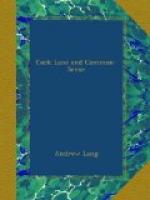Such are the hostile and distracting influences, the contending currents, in the midst of which Reason has to operate as well as she can. Meanwhile every one of us probably supposes himself to be a model of pure reason, and if people would only listen to him, the measure of the universe. This happy and universal frame of mind is agreeably illustrated in a work by the late Comte Agenor de Gasparin, Les Tables Tournantes (Deuxieme edition: Levy, Paris, 1888). The first edition is of 1854, and was published at a time of general excitement about ‘table-turning’ and ‘spirit-rapping,’ an excitement which only old people remember, and which it is amazing to read about.
Modern spirit-rapping, of which table-turning is a branch, began, as we know, in 1847-48. A family of Methodists named Fox, entered, in 1847, on the tenancy of a house in Hydesville, in the State of New York. The previous occupants had been disturbed by ‘knocking,’ this continued in the Fox regime, one of the little girls found that the raps would answer (a discovery often made before) a system of alphabetic communication was opened, and spiritualism was launched. {307} In March, 1853, a packet of American newspapers reached Bremen, and, as Dr. Andree wrote to the Gazette d’Augsbourg (March 30, 1853), all Bremen took to experiments in turning tables. The practice spread like a new disease, even men of science and academicians were puzzled, it is a fact that, at a breakfast party in Macaulay’s rooms in the Albany, a long and heavy table became vivacious, to Macaulay’s disgust, when the usual




